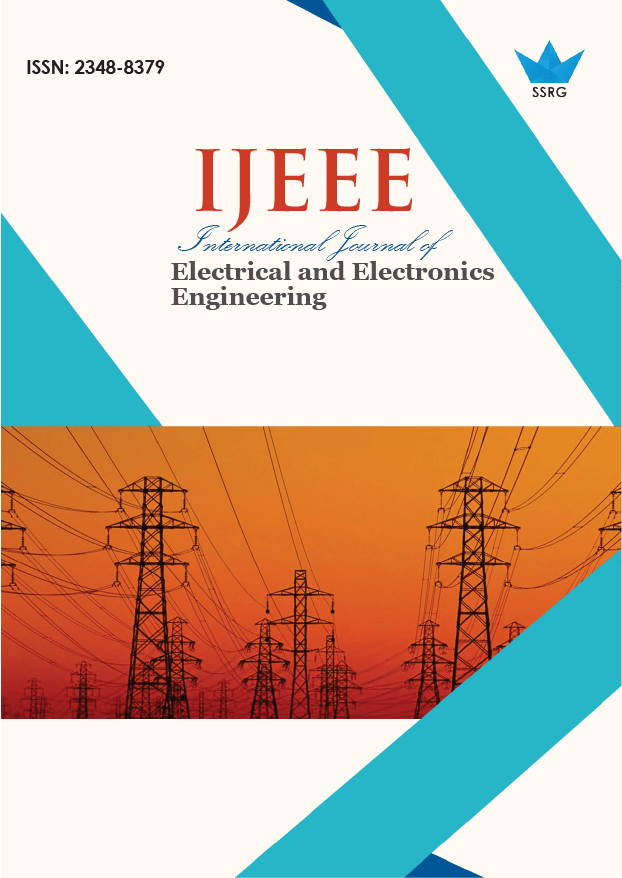Design and Performance Analysis of Polarization Reconfigurable Antenna using a Hybrid Coupler

| International Journal of Electrical and Electronics Engineering |
| © 2025 by SSRG - IJEEE Journal |
| Volume 12 Issue 8 |
| Year of Publication : 2025 |
| Authors : Bammidi Deepa, K Chandra Bhushana Rao |
How to Cite?
Bammidi Deepa, K Chandra Bhushana Rao, "Design and Performance Analysis of Polarization Reconfigurable Antenna using a Hybrid Coupler," SSRG International Journal of Electrical and Electronics Engineering, vol. 12, no. 8, pp. 20-28, 2025. Crossref, https://doi.org/10.14445/23488379/IJEEE-V12I8P103
Abstract:
Antennas for wireless signals must be reconfigurable because these detectors need to deal with several polarization options to enhance the link's reliability and limit loss. The antenna system proposed in this study works at S-band frequencies between 2.1 and 2.8 GHz. The configuration is novel since a hybrid coupler allows linking two networks via a dual-layer antenna consisting of a network and a patch element printed over FR4. This hybrid coupler allows precise control over the current distribution in the patch and, as a result, allows this device to transition between polarization states continuously, including LP, LHCP and RHCP. Conversion from circular to linear polarization is achieved by manipulating the phase using a matrix of well-positioned PIN diode switches (SMP1345-079LF). This single-feed configuration allows some flexibility in operations and guarantees that performance in polarization is given to equal reliability, independent of the mode being excited. From the performance analysis, the antenna achieves approximately 6dB of gain and remains operational at a consistent level within the desired frequency band. Due to its versatility, the design can be useful in the S-band spectrum, wireless networks, navigation, meteorology, and aviation surveillance for air traffic management, improving the performance of the systems and requiring less hardware than earlier solutions.
Keywords:
PIN diodes, Polarization reconfigurable antenna, Hybrid coupler, Theory of characteristic modes, Two-layered antennas.
References:
[1] Constantine A. Balanis, Antenna Theory: Analysis and Design, 3rd ed., A John Wiley & Sons, Hoboken, New Jersey, 2005.
[Google Scholar] [Publisher Link]
[2] Ramesh Garg et al., Microstrip Antenna Design Handbook, Artech house, Boston, London, 2001.
[Google Scholar]
[3] Kanniyappan Vinayagam, and Rajesh Natarajan, “Polarization Reconfigurable Patch Antenna Using Parasitic Elements for Sub-6 GHz Applications,” International Journal of Electrical and Computer Engineering Systems, vol. 16, no. 1, pp. 1-7, 2024. [CrossRef] [Google Scholar] [Publisher Link]
[4] Xianjing Yuan et al., “A Wideband Polarization-Reconfigurable Antenna Based on Fusion of TM10 and Transformed-TM20 Mode,” Electronics, vol. 13, no. 18, pp. 1-12, 2024.
[CrossRef] [Google Scholar] [Publisher Link]
[5] Jun Xiao et al., “High‐Gain and Low-Cost Circularly Polarized Antenna Array for 5G MMW Applications,” IET Microwaves, Antennas & Propagation, vol. 16, no. 2-3, pp. 174-184, 2022.
[CrossRef] [Google Scholar] [Publisher Link]
[6] Haoran Zhao, Binyun Yan, and Weixing Sheng, “A Beamwidth and Beam Direction Reconfigurable Antenna based on Multi-Mode Parasitic Coupling,” IET Microwaves, Antennas & Propagation, vol. 18, no. 8, pp. 578-584, 2024.
[CrossRef] [Google Scholar] [Publisher Link]
[7] Chao Liu et al., “Polarization Reconfigurable and Beam-Switchable Array Antenna Using Switchable Feed Network,” IEEE Access, vol. 10, pp. 29032-29039, 2022.
[CrossRef] [Google Scholar] [Publisher Link]
[8] Shenyun Wang et al., “Polarization-Reconfigurable Antenna Using Combination of Circular Polarized Modes,” IEEE Access, vol. 9, pp. 45622-45631, 2021.
[CrossRef] [Google Scholar] [Publisher Link]
[9] Jehison Leon Valdes et al., “A Polarization Reconfigurable Patch Antenna in the Millimeter-Waves Domain Using Optical Control of Phase Change Materials,” IEEE Open Journal of Antennas and Propagation, vol. 1, pp. 224-232, 2020.
[CrossRef] [Google Scholar] [Publisher Link]
[10] Peng Liu et al., “Broadband and Low-Profile Penta-Polarization Reconfigurable Metamaterial Antenna,” IEEE Access, vol. 8, pp. 21823-21831, 2020.
[CrossRef] [Google Scholar] [Publisher Link]
[11] Salma Syed et al., “Christmas-Tree Shaped Compact Microstrip Textile Antenna for Telemetry, ISM and X-band Applications,” Materials Today: Proceedings, vol. 80, pp. 1665-1670, 2023.
[CrossRef] [Google Scholar] [Publisher Link]
[12] Yuwei Zhang et al., “Wideband Pattern and Polarization-Reconfigurable Antenna Based on Bistable Composite Cylindrical Shells,” IEEE Access, vol. 8, pp. 66777-66787, 2020.
[CrossRef] [Google Scholar] [Publisher Link]
[13] Yi Zhou et al., “A Liquid-Metal-Based Crossed-Slot Antenna with Polarization and Continuous-Frequency Reconfiguration,” IEEE Open Journal of Antennas and Propagation, vol. 3, pp. 1102-1108, 2022.
[CrossRef] [Google Scholar] [Publisher Link]
[14] D. Ram Sandeep et al., “Material Selection to Modeling: A Comprehensive Investigation of a Conformal Circularly Polarized Textile Antenna for Wearable Applications,” IEEE Access, vol. 13, pp. 110882-110899, 2025.
[CrossRef] [Google Scholar] [Publisher Link]
[15] Junyi Huang, M. Shirazi, and Xun Gong, “A New Arraying Technique for Band-Switchable and Polarization-Reconfigurable Antenna Arrays with Wide Bandwidth,” IEEE Open Journal of Antennas and Propagation, vol. 3, pp. 1025-1040, 2022.
[CrossRef] [Google Scholar] [Publisher Link]
[16] Wanchen Yang et al., “Advanced Metasurface-Based Antennas: A Review,” IEEE Open Journal of Antennas and Propagation, vol. 6, no. 1, pp. 6-24, 2025.
[CrossRef] [Google Scholar] [Publisher Link]
[17] Htet Wai Htun, Eisuke Nishiyama, and Ichihiko Toyoda, “A Single-Layer Planar Array Antenna Using Circularly-Polarized Reconfigurable Elements for Conical-Beam Radiation,” IEEE Access, vol. 12, pp. 125306-125318, 2024.
[CrossRef] [Google Scholar] [Publisher Link]
[18] Sangeetha Subbaraj, and Shweta B. Thomas, “Reconfigurable Antennas and Their Practical Applications - A Review,” Radio Science, vol. 58, no. 9, pp. 1-13, 2023.
[CrossRef] [Google Scholar] [Publisher Link]
[19] D. Ram Sandeep et al., “Functional Analysis in the Body Environment for a Circularly Polarized Hybrid Reconfigurable Textile Antenna,” Physica Scripta, vol. 98, no. 10, 2023.
[CrossRef] [Google Scholar] [Publisher Link]
[20] Changying Wu et al., “Methodology to Reduce the Number of Switches in Frequency Reconfigurable Antennas with Massive Switches,” IEEE Access, vol. 6, pp. 12187-12196, 2018.
[CrossRef] [Google Scholar] [Publisher Link]

 10.14445/23488379/IJEEE-V12I8P103
10.14445/23488379/IJEEE-V12I8P103